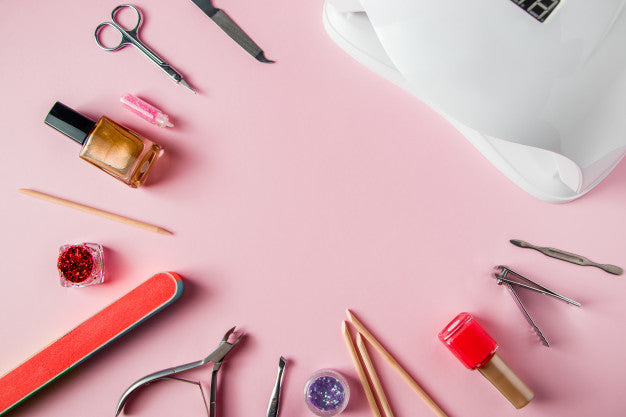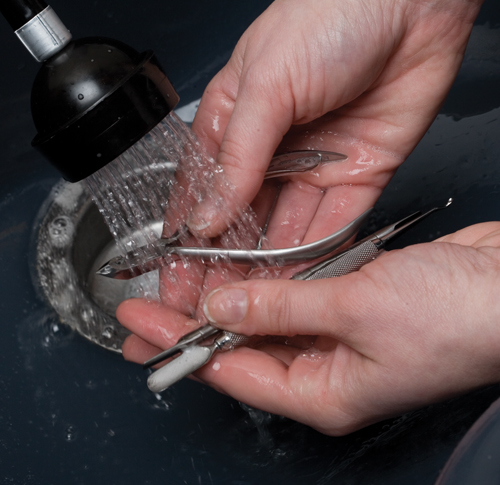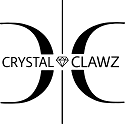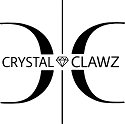How to Clean Nail & Beauty Tools in a Salon
Before we get started, make sure you know the difference between sanitizing, sterilization and disinfecting... Sanitize simply means “to clean,” as in, removing all visible debris from a surface. When you sanitize, you remove the majority of bacteria, viruses, and fungi, while disinfection kills the remaining amount. You must sanitize before disinfecting, or the bits of debris that come off in the disinfecting solution break down the solution’s active ingredients, and make it less effective. Disinfection requires soaking the implement in disinfectant solution for a full ten minutes. This step kills any leftover pathogens on the tool, making it safe for you to use on your next client. Sterilizing kills all microorganisms present, including the spores. The first thing you need to do is to gather together all multi-use nail tools that are suitable for proper disinfection. This usually includes hard and non-absorbent nail tools such as:- Metal nail clippers
- Metal or glass nail files
- Electric nail file bits
- Any plastic or metal cuticle pushers or nail art sticks
- Manicure bowls
- Nail cleaning brushes
Different Types of Items:
Single-use tools (orangewood sticks, cotton balls, and disposable toe separators) must be thrown out after use on a client. Multi-use tools are divided into porous, non-porous, and self-disinfecting, which determines how they should be handled:- Porous (absorbent) items: towels, cushioned abrasive files and buffers Should be disinfected with: 70-90% isopropyl or ethyl alcohol *Note: If one of these porous materials comes into contact with broken or infected skin, it should be double bagged and thrown away into a closed receptacle.
- Non-porous (non-absorbent) items: Metal, glass, and fiberglass tools like metal nippers, cuticle pushes, and electric file bits Should be disinfected with: hospital grade disinfectant registered with the Environmental Protection Agency (EPA) *Note: Any non-porous implement that comes in contact with broken or infected skin must immediately be sanitized and disinfected.
- Self-disinfecting items: nail polish, primers, liquid monomer, and gels Should be disinfected with: Nothing! The containers these products come in do not support the growth of pathogens due to lack of water or high-alcohol content. *Note: Cuticle oils do support pathogen growth, so it’s best to dispense these in a dropper where brush does not come into contact with the finger.

How to Disinfect Nail & Beauty Tools
To properly clean and disinfect your nail or beauty tools, the step-by-step process should look like this:- Sanitize all reusable tools by washing them
- Dry them with a clean towel
- Submerge them in disinfectant for at least 10 minutes
- Either remove them or leave them in a disinfectant jar on your station
- If removed, place them in a sterilizer or clean draw
- After sterilization, leave your nails tools in the sterilizer until you are ready to use them

Do You Need to Sterilise Your Nail Implements?
The majority of the time, thorough disinfection is enough for your nail and beauty tools without the need for sterilization. However, if you tools ever come into contact with blood or bodily fluids, you do need to sterilize them straight away. There are some other scenarios that would require you to sterilize nail tools, too – such as to minimize the risk of transmitting Covid-19. If you did want to sterilize your nail tools, you would still need to sanitize and disinfect them as outlined above. You can then place them in an appropriate sterilizer. Once sterilized, you can use your sterilizing unit to store your cleaned tools until you need them. A double draw sterilizer is handy for keeping your tools on a hygiene rotation.
How Do You Clean a Nail Buffer or Emery Board?
Cleaning non-porous tools made from metal and glass is straight forward. But, what about porous abrasives, such as buffers and nail files? You still need to disinfect these implements if they are not single use. The same process should still apply – you need to remove all the dust, wash them and apply a disinfectant for the required amount of time. If you can’t completely submerge your nail buffer in disinfectant, you can spray it directly onto the surface instead. Be sure to sanitize your work environment before and after each client for a safe, clean space!
Loved our blog? Take a look at our latest posts by clicking HERE.
Be sure to sanitize your work environment before and after each client for a safe, clean space!
Loved our blog? Take a look at our latest posts by clicking HERE.




